1 - 25 of 10
| Creator | Title | Description | Subject | Date | ||
|---|---|---|---|---|---|---|
| 1 |
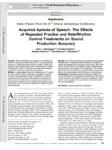 |
Wambaugh, Julie L. | Acquired apraxia of speech: the effects of repeated practice and rate/rhythm control treatments on sound production accuracy | Purpose: This investigation was designed to elucidate the effects of repeated practice treatment on sound production accuracy in individuals with apraxia of speech (AOS) and aphasia. A secondary purpose was to determine if the addition of rate/rhythm control to treatment provided further benefits be... | 2012-01-01 | |
| 2 |
 |
Ferguson, Sarah Hargus | Across-talker effects on non-native listeners' vowel perecption in noise | This study explored how across-talker differences influence non-native vowel perception. American English (AE) and Korean listeners were presented with recordings of 10 AE vowels in /bVd/ context. The stimuli were mixed with noise and presented for identification in a 10-alternative forced-choice t... | 2010 | |
| 3 |
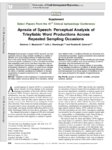 |
Wambaugh, Julie L. | Apraxia of speech: perceptual analysis of trisyllabic word productions across repeated sampling occasions | Early apraxia of speech (AOS) research has characterized errors as being variable, resulting in a number of different error types being produced on repeated productions of the same stimuli. Conversely, recent research has uncovered greater consistency in errors, but there are limited data examining ... | 2011-01-01 | |
| 4 |
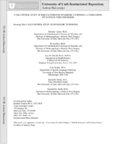 |
Roy, Nelson | Case-control study of risk factors for spasmodic dysphonia: a comparison with other voice disorders | Objectives: This epidemiology study examined risk factors uniquely associated with spasmodic dysphonia (SD). Study Design: Case-control. Methods: A questionnaire was administered to 150 patients with SD (with and without coexisting vocal tremor) and 136 patients with other structural, neurological, ... | 2012-01-01 | |
| 5 |
 |
Chapman, Kathy L. | Early lexical characteristics of toddlers with cleft lip and palate | Main Outcome Measures: The groups were compared for size of expressive lexicon reported on the MacArthur Communicative Development Inventory and the percentage of words beginning with obstruents and sonorants produced in a language sample. Differences between groups in the percentage of word initial... | 2014-01-01 | |
| 6 |
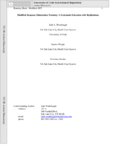 |
Wambaugh, Julie L. | Modified response elaboration training: a systematic extension with replications | Background: Response Elaboration Training (RET; Kearns, 1985) has been found to consistently result in increased production of content in discourse with persons with aphasia. Positive treatment effects have been reported for persons representing a variety of aphasia types and severities. RET was mod... | 2012-01-01 | |
| 7 |
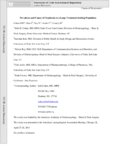 |
Roy, Nelson | Prevalence and causes of dysphonia in a large treatment-seeking population | Objective: To determine the prevalence and common causes of dysphonia as diagnosed by primary care physicians (PCPs) and otolaryngologists, and to evaluate differences in etiologies offered by these providers. Study Design: Retrospective analysis of data from a large, nationally representative admin... | 2012-01-01 | |
| 8 |
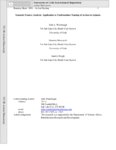 |
Wambaugh, Julie L. | Semantic feature analysis: Application to confrontation naming of actions in aphasia | Background: Despite advances in the development and testing of therapies for verb retrieval impairments in aphasia, generalization effects of treatment remain a challenge. Semantic Feature Analysis (SFA) is a word retrieval treatment that has been reported to result in generalized responding to untr... | 2014-01-01 | |
| 9 |
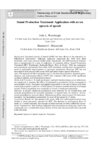 |
Wambaugh, Julie L. | Sound production treatment: application with severe apraxia of speech | Acquired apraxia of speech (AOS) has been shown to be responsive to behavioural intervention. Although numerous treatments for AOS have been developed, most have received limited study. Specifically, the AOS treatment evidence base is compromised by a lack of replication of treatment effects. Sound ... | 2010-01-01 | |
| 10 |
 |
Blomgren, Michael | Stuttering treatment outcomes measurement: assessing above and below the surface | Most researchers now acknowledge that stuttering is a multidimensional disorder (Smith & Kelly, 1997). Therefore, any assessment of stuttering treatment requires a multifaceted approach. A multifaceted approach typically includes assessing both surface elements as well as elements of stuttering that... | 2007-11-01 |
1 - 25 of 10
